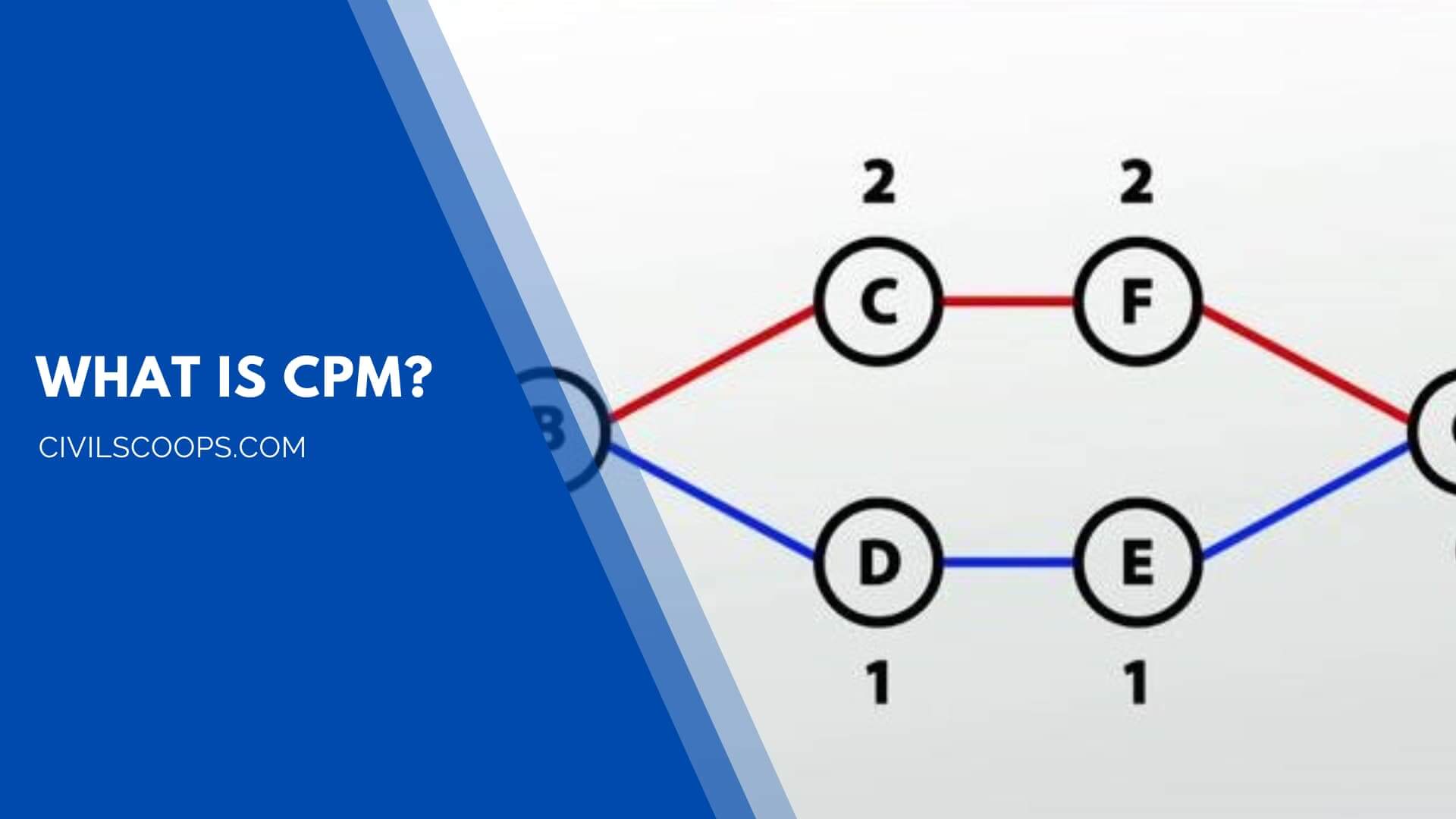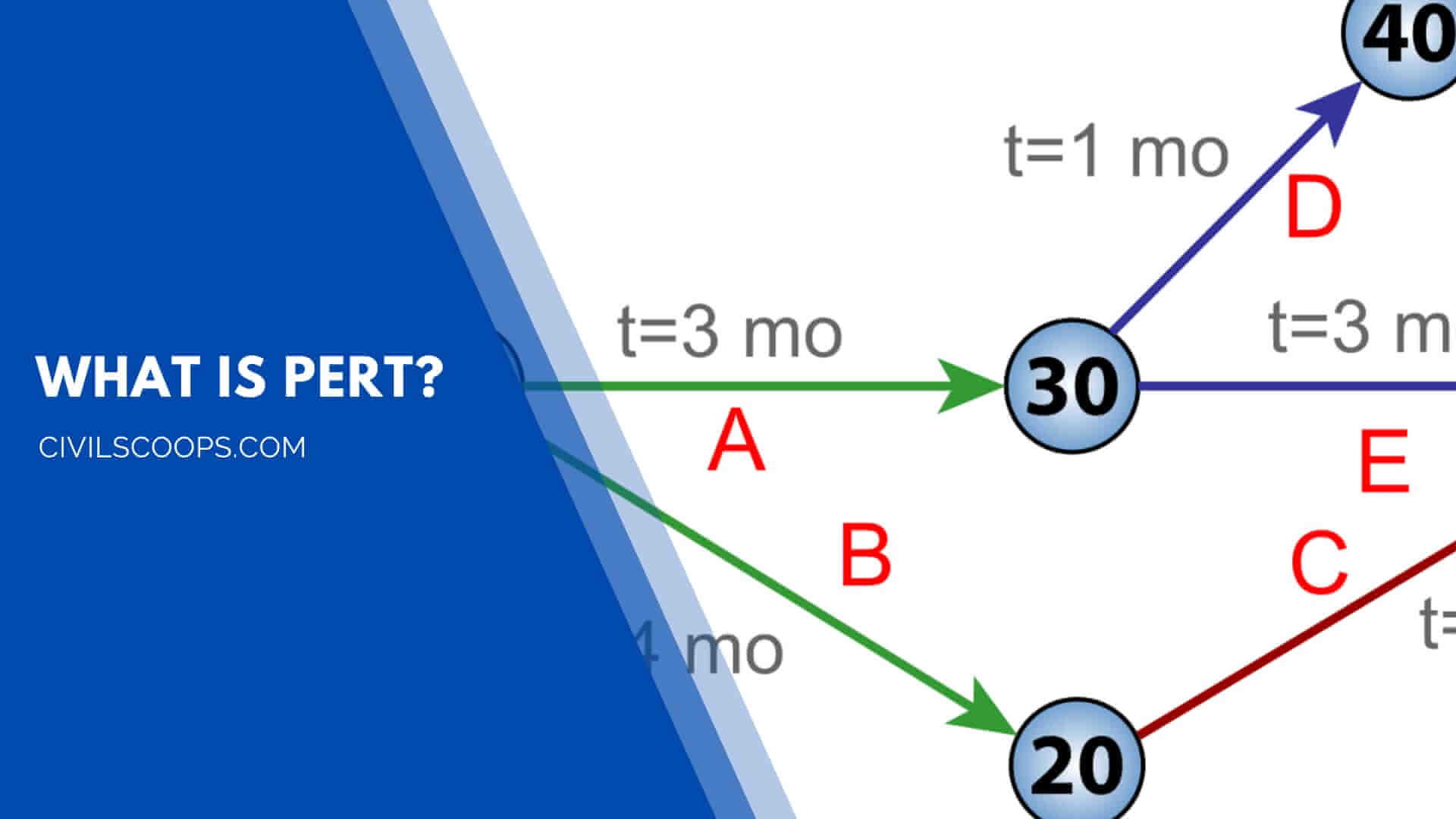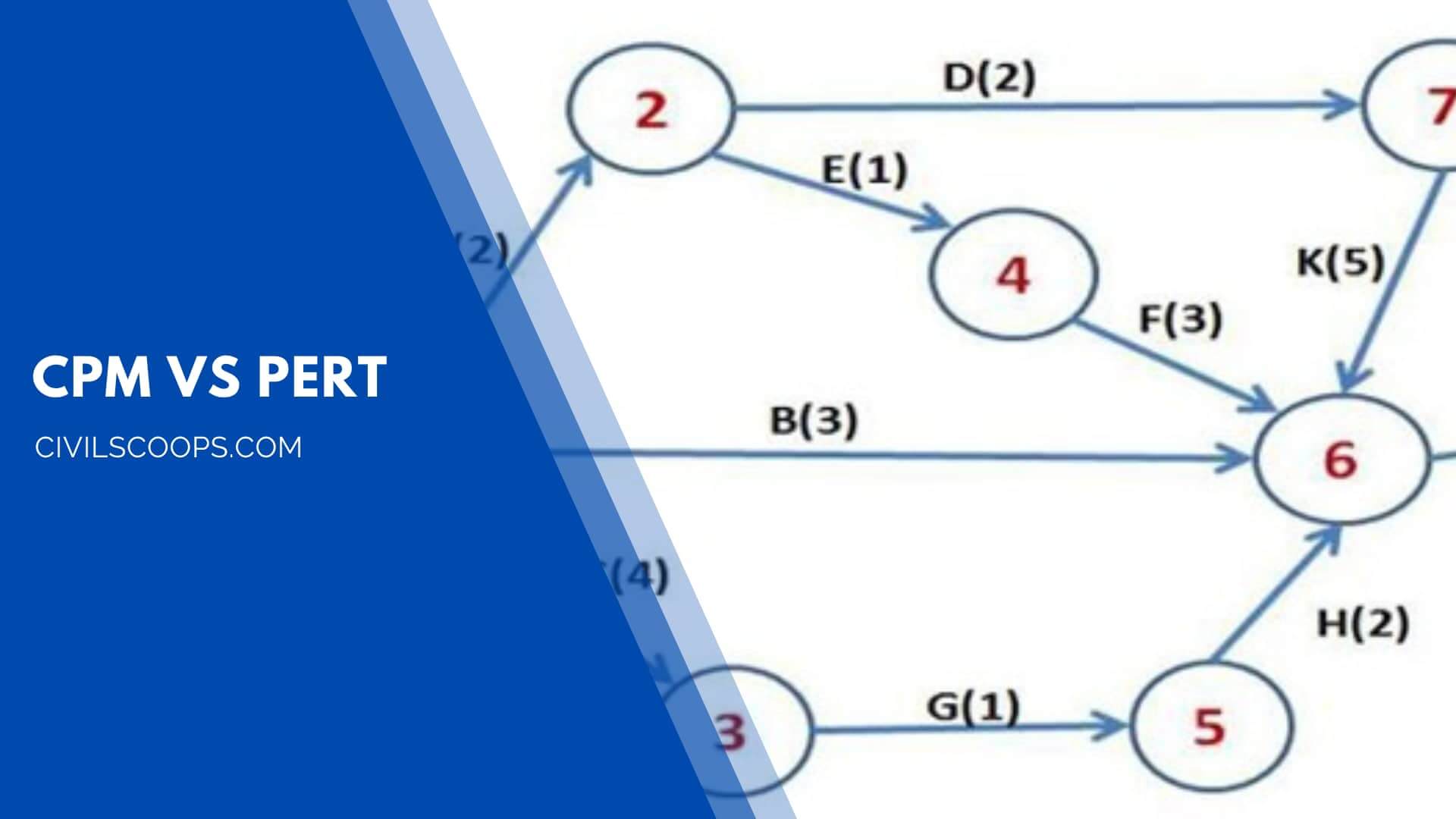14 Difference Between CPM and PERT | What Is CPM | What Is PERT

The network technique is a major advance in management science.
This technique is based on the basic characteristics of all projects, that all work must be done in well-defined steps. For example, for completing a foundation, the various steps are (1) Layout, (ii) Digging, (iii) Placing Sideboards, and (iv) Concreting.
The network technique exploits this characteristic by representing the steps of the project objective graphically in the form of a network or arrow diagram.
It would be difficult to find in the history of management methods any technique which has received such widespread attention as that accorded to network methods for planning, scheduling, and controlling.
The network techniques are called by various names such as PERT, CPM, UNETICS, LESS, TOPS, and SCANS. However, these and other systems have emerged from the following two major network systems:
- CPM
- PERT
Table of Contents
What Is CPM?

CPM Full name Critical Path Method
Critical Path Method (CPM) is an effective tool for scheduling the activities of a complex Project. It was developed by Morgan R. Walker of DuPont and James E. Kelley Jr. of Remington in 1950.
In CPM networks, the entire project consists of a number of clearly recognizable operations or jobs, called activities. Activities are usually operations that take time to carry out, and on which resources are an expense.
Junctions between activities are term as events. The CPM networks are often referred to as activity-oriented diagrams in which an arrow represents each activity, and the sequence of the arrows shows the sequence in which the activities are performed.
For example, at a foundation construction project, the various activities may be the layout of the foundation trench’, ‘excavating the foundation,’ ‘put sideboards,’ ‘concrete the foundation base,’ etc.
CPM network is generally used for repetitive kind projects, or for those projects for which a quite accurate estimate of time for completion of each activity may be made; and for which cost estimations may be made using a fair degree of accuracy.
For example, CPM is very helpful for construction projects. But it isn’t suitable for development and research projects.
CPM Basic Steps:
- Determine the required tasks
- List required tasks in sequence
- Create a flowchart including each required task
- Identify all critical and non-critical relationships (paths) among the required tasks
- Assign an expected completion/execution time for each required task
- Study all critical relationships to determine all possible alternatives or backups for as many as possible
What Is PERT?

PERT full name Program Evaluation Review Technique
This PERT method First developed by the United States Navy in 1958, is commonly used in conjunction with the critical path method in the year 1957 (CPM).
The method was developed by the Navy Special Projects Office in cooperation with Booz, Allen, and Hamilton, a management consulting firm, also Lockheed Missile System Division for assessing the feasibility of existing schedules on Polaris missile program and for reporting progress.
The PERT system uses a network diagram consisting of events that have to be established to reach project objectives. An event is that particular instant of time where some specific part of a plan is to be achieved.
It indicates a point in time and does not require any resources. PERT uses event-oriented network diagrams in which arrows join successive events.
For example, at a foundation construction project, the various events could be ’foundation layout started,” foundation excavated,” sideboards fixed,” concreting completed’ etc.
The approach of event-orientation in the network diagram grew out of the desire to report on the project progress via discernible management milestones.
PERT Basic Steps:
- Identifying Tasks and Milestones: Each project involves a series of required tasks. These tasks are listed in a table, permitting additional information on timing and sequence to be added later.
- Placing the Tasks in a Proper Sequence: The tasks Have Been Examined and placed in a sequence to get the desired results.
- Network Diagramming: A network diagram is drawn with the activity sequence data showing the sequence of concurrent and sequential activities.
- Time Estimating: Here Can Be the time required to carry out each activity, in three parts:
- Optimistic timing: The shortest time to complete an activity Most likely timing: The completion time having the highest probability Pessimistic timing: The longest time to complete an activity
- Critical Path Estimating: This determines the entire time required to complete a project.
CPM Vs PERT

[su_table responsive=”yes” alternate=”no”]
| Sr.No. | CPM | PERT |
| 1 | CPM full name Critical Path Method | PERT full name Program Evaluation Review Technique |
| 2 | PERT is that technique of project management which is used to manage uncertain (i.e., time is not known) activities of any project. | CPM is that technique of project management which is used to manage only certain (i.e., time is known) activities of any project. |
| 3 | The CPM is a statistical technique of project management this is managed well-defined activities of a project. | The PERT is a project management technique, used to manage uncertain activities of a project. |
| 4 | This CPM is a method to control cost and time. | The PERT is a technique of planning and control of time. |
| 5 | CPM Method orientation like Activity-oriented | PERT Method orientation like Event-oriented |
| 6 | In CPM method evaluation of Evolved as Construction project | In this method evaluation of Evolved as a Research & Development project |
| 7 | Model type Deterministic | Model type Probabilistic |
| 8 | In this method Focus on Time-cost trade-off | In this method Focus on Time |
| 9 | CPM Method calculated estimates only one-time estimate | Here, the PERT method estimates Three-time estimates |
| 10 | Appropriate for Reasonable time estimates | Appropriate for High precision time estimate |
| 11 | Management of Predictable activities | Management of Unpredictable Activities |
| 12 | Nature of jobs Repetitive nature | Nature of jobs non-repetitive nature |
| 13 | Critical and Non-critical activities is Differentiation | Critical and Non-critical activities are No Differentiated |
| 14 | Use in Research and Development Project | Use in Non-research projects like civil construction, shipbuilding etc. |
[/su_table]
[su_box title=”FAQ” style=”default” box_color=”#333333″ title_color=”#FFFFFF” radius=”3″ class=”” id=””]
What Is Cpm?
The critical path method (CPM) is a technique where you identify tasks that are necessary for project completion and determine scheduling flexibilities. A critical path in project management is the longest sequence of activities that must be finished on time in order for the entire project to be complete.
What Does Cpm Stand For?
CPM stands for Critical Path Method.
What Is Pert?
The program evaluation and review technique is a statistical tool used in project management, which was designed to analyze and represent the tasks involved in completing a given project.
What Is Pert and Cpm?
The Program Evaluation Review Technique, or PERT, is a visual tool used in project planning. Using the technique helps project planners identify start and end dates, as well as interim required tasks and timelines. The information is displayed as a network in chart form.
CPM is a technique which is used for the projects where the time needed for completion of project is already known. It is majorly used for determining the approximate time within which a project can be completed.
What Is a Pert Chart?
Program evaluation and review technique (PERT) charts are useful when managing a project. It is used to streamline project planning and scheduling. The method is particularly useful when time is the critical factor in the project and when the details of each project task or phase are not necessarily known.
What Is the Pert and Cpm?
PERT is a popular project management technique that is applicable when the time required to finish a project is not certain. CPM – CPM is a statistical algorithm which has a certain start and end time for a project.
What Is a Pert Diagram?
The main goal of a PERT diagram is to analyze, review and demonstrate the tasks which are required to complete a project. It is a project management tool which -unsurprisingly- used mostly by project managers. This statistical tool generally focuses on the required time to complete the mentioned tasks and the comparison between each other.
What Is Pert Cpm Chart?
PERT Chart – A PERT chart (program evaluation review technique) is a form of diagram for CPM that shows activity on an arrow diagram. PERT charts are more simplistic than CPM charts because they simply show the timing of each step of the project and the sequence of the activities.
What Is Pert Chart Used For?
PERT charts should be used when a project manager needs to:
- determine the project’s critical path in order to guarantee all deadlines are met.
- display the various interdependencies of tasks.
- estimate the amount of time needed to complete the project; and
- prepare for more complex and larger projects.
Difference Between Cpm and Pert
Another big difference between CPM and PERT is the technique of the PM tool. CPM is what you call an activity-oriented technique, which means that what’s most important when planning the project are the tasks, the amount of time spent on tasks, and the resources needed to complete them. PERT is an event-oriented technique.
Pert and Cpm Difference
Another key difference between PERT and CPM is the way they approach scheduling. PERT is a forward-looking method, meaning that it is used to plan and schedule the tasks in a project. CPM, on the other hand, is a backward-looking method, meaning that it is used to monitor and control the progress of a project.
What Is Critical Path Method Example?
A Critical Path Method Example
Step 1: Divide the Project into Tasks The first step is to divide the project into tasks, also known as activities.
Step 2: Estimate Tasks Let’s get into the meat & potatoes.
Step 3: Create the Network Diagram.
Step 4: Draw Initial Gantt (bar) Chart.
What Is Critical Path Method?
The critical path method (CPM) is a technique where you identify tasks that are necessary for project completion and determine scheduling flexibilities. A critical path in project management is the longest sequence of activities that must be finished on time in order for the entire project to be complete.
What Is Program Evaluation and Review Technique?
The Program Evaluation Review Technique, or PERT, is a project management tool used in project planning to calculate the amount of time it will take to realistically finish a project. Using the technique helps project planners identify the start and end dates.
[/su_box]
[su_note note_color=”#F2F2F2 ” text_color=”#333333″ radius=”3″ class=”” id=””]
Like this post? Share it with your friends!
Suggested Read –
- All About Uscs | Which Test Gives a Better Estimation of the Friction Angle | Introduction of USCS ( Unified Soil Classification System )
- What Is Sewerage | What Is Storm Drain | Household Drain Systems | House Drainage Parts and Components | Types of Sewer Pipes | Sanitary Pipework
- What Are Defects in Painting | 18 Types of Defects in Painting | How to Prevent Defects in Painting
- Top 10 Companies for Environmental Engineers to Work For
- What Is Consistency of Cement | What Is Initial Setting Time of Cement | What Is Final Setting Time of Cement
[/su_note]
Originally posted 2023-01-27 12:34:38.
